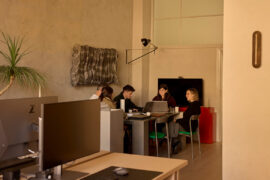Industrial design is a tough industry to crack. And mentorship is one thing that is not always part of the university curriculum. QUT’s Rafael Gomez shares his wisdom on mentorship and being a well-rounded designer with Indesignlive.
February 23rd, 2018
Ahead of the next iteration of Launch Pad, a long-running product design competition and mentorship program, we wanted to take a look at the value of mentoring. Sharing his insight and industry experience with us is Rafael Gomez, industrial design subject coordinator and lecturer at Queensland University of Technology.
Mentorship generally comes once you’re already on your way in your career. Being mentored and having someone with scores more knowledge than you share their insight and offer guidance can be invaluable. Here’s why, and how to go about getting it…
Rafael Gomez: Mentorship is important in a field like industrial design for two reasons – firstly, students jumping into industrial design don’t always have an in-depth knowledge of what the field is and secondly they don’t know where they can take their career once they graduate. Often the earlier a student gets guidance on what the field is and where they can apply their skills, they are better placed to shape their foundation learning at university and beyond.
The most important piece of advice is to allow yourself time to work out where your passion is and where to take your career. As Industrial Designers you will be faced with a variety of options about where to apply your skills – in traditional design consultancies, in in-house design teams, entrepreneurship and small business start-ups, interaction design, user experience design, service design, and many other areas.
The skills you learn at university, especially at QUT, are broad and very applicable across a variety of different fields. This is certainly an advantage, but you need to give yourself time to identify what it is you are passionate about and then home in on that as you develop as a professional designer.
There are two key things here. First is to network as much as possible, get yourself out there and talk to people in the field and find like-minded designers. Join related Facebook groups, set-up a professional LinkedIn page, try and develop a professional website and folio as soon as possible. Also, go to social networking events, join professional organisations like the Design Institute of Australia, attend networking events, and try and get involved in internships if possible.
Once you get to know designers and people working in the field, find the ones that inspire you. Start with your lecturers and tutors at university, who often have industry experience, and also reach out to experienced designers in the field. What is it about their careers that you can learn from? How have they achieved success within their careers? Try and contact them and organise to have a coffee or chat to learn more about how they do what they do and how you can learn from that for your own path.
One final thing I would add is to get a variety of opinions and feedback, don’t just rely on one person’s viewpoint to make decisions about your future career choices. It’s important to understand that one person’s opinion is based purely on their individual life experience, which might not be suitable for your own.
From my experience in teaching design for over 10 years I would say that well-rounded and successful designers are ones who are passionate about what they do. They love their work.
Of course there is still a lot of hard work, sweat and tears to refine and hone those skills in the real world, but once you find that passion then everything becomes easier – it no longer feels like work.
I also feel that international travel is an incredible thing for young designers – it helps you mature, experience different cultures, see design from a different perspective, and often inspires young designers to bigger and greater things.
Manufacturing is an important and central part of the traditional industrial design discipline and is prerequisite knowledge to begin your career in the field. Nevertheless, I am seeing more and more industrial designers graduating and having great success nationally and internationally without expert knowledge in manufacturing. There are two potential factors for this. The first has to do with the advent of industry 4.0 infiltrating the sector and so more companies are rapidly shifting towards advanced automated manufacturing systems that require different manufacturing knowledge than before. So traditional knowledge about manufacturing as we know it is becoming less relevant than before.
The other factor has to do with the way that designers are applying their skillsets in the real world. More and more industrial designers are being taught skills that can be applied beyond the traditional product design realm – so as to prepare them for the dramatic changes that are happening in terms of automation, artificial intelligence, robotics and so on.
Design knowledge and skills can be applied in all sorts of ways and with the complex challenges facing the world and humankind this century we need designers that are flexible, dynamic, sharp and can manage an interdisciplinarity workforce – as a result, designers are working in all sorts of areas beyond traditional product design industries.
One final thing I would say is that if you’ve been helped and mentored as a young designer and you go to succeed in the field, don’t forget to give back. As mentioned before the design field is small in Australia (and globally) and the more we help each other the more the field will grow, evolve and prosper.
–
INDESIGN is on instagram
Follow @indesignlive
A searchable and comprehensive guide for specifying leading products and their suppliers
Keep up to date with the latest and greatest from our industry BFF's!

Rising above the new Sydney Metro Gadigal Station on Pitt Street, Investa’s Parkline Place is redefining the office property aesthetic.

Carr’s largest residential project to date integrates concrete, steel mesh and landscape across 122 apartments in Melbourne’s Brunswick.

Type designer Vincent Chan, who delivered a keynote speech with the Powerhouse as part of Sydney Design Week, tells us about the history and importance of this niche profession.
The internet never sleeps! Here's the stuff you might have missed

The Australian Design Centre (ADC) has announced that the organisation can no longer continue without adequate government funding to cover operational costs.

Sydney Open invites the public to explore over 55 buildings, spaces and new additions to the skyline, with a newly released Talks & Tours program offering direct access to the architects behind Bundarra and Pier Pavilion.

Founded by Ana Ćalić McLean and Josh McLean, In Addition is a design studio creating thoughtful, client-focused architecture and interiors.

Cieran Murphy has been awarded The Photographer – Commercial at the INDE.Awards 2025. His work on Lune Rosebery captures the immersive design and storytelling of the space, highlighting the interplay of form, material and atmosphere in this contemporary culinary destination.